Monogram 1/48 F-8E, MiG-killing Crusader
My latest effort is the old, but solid, Monogram 1/48 F-8E Crusader.
This classic from Monogram features average fit, with (mostly) accurate outlines and shapes. It has raised panel lines, which also appear accurate compared to drawings and photos in my references. There is one glaring mistake: the entire nose, from aft of the canopy to the end of the nose, is one quarter inch (or one scale foot) too wide. This gives the windscreen and canopy a flattened appearance compared to the actual aircraft. Monogram made this same mistake on their 1/48 A-4 E/F Skyhawk kit. Another flaw, though one more easily remedied, is an incorrect seat. The kit seat looks more like one from a Tomcat or Intruder, rather than the correct Martin-Baker Mk F5 or F7 seat. The sit of the landing gear, especially the mains, is too low, and needs to be corrected. Inaccuracies aside, the kit can still be built into a fine and relatively accurate model with a little work, and some help from the spares box and aftermarket parts. But why bother, when the far superior Hasegawa Crusader is readily available? First, I'm a Crusader nut, and I bought several Monogram Crusaders before the Hasegawa kit was released. I had it in the stash, and every once and a while, I enjoy the challenge of updating and improving older kits. Second is cost, but not by much - you can get two or three Monogram/Revell Crusaders for the price of one Hasegawa kit. However, you must factor in the cost of a resin replacement seat, and if you raise the wing, the underwing bay (unless you scratchbuild it yourself) and replacement landing gear (again, unless you modify the kit gear yourself), and decals (the kit decals may be useable, but are old and very thick). By the time you purchase update sets, you may still be under the cost of a Hasegawa kit, but just barely. And you still have a kit with a nose that's a scale foot too wide. Another reason I chose to build it is that I had already purchased the excellent Furball Aero Design sheet of MiG-killing Crusaders, and wanted to add another F-8 MiG-killer to my collection, so this was a slightly less expensive way to do so.
Here's a list of additions and modifications I made to the kit to bring it up to snuff:
The kit cockpit needs replacement seat, but has a good insturment panel and side consoles. The area behind the seat, though, is void of any detail at all, so I used a resin cockpit from Black Box, which can be had for around $10 these days. But use the kit instrument panel, as it is more accurate for the F-8E. The bulkhead at the rear of the canopy was replaced - the kit piece is too thick and has raised lines, but the actual bulkhead was thin sheet metal with stamped indentations. I cut a thin piece of sheet plastic to shape, and carved in the grooves. The front windscreen was detailed with a grab handle, and a stand-by compass. I added rearview mirrors and a restraint strap to the canopy. Monogram didn't provide an afterburner nozzle, so I created one from an old F-18 exhaust cone from the spares box. Before closing up the fuselage, I cut out the boarding steps. The afterburner cooling scoops were hollowed out for a more realistic appearance before attachment to the tail. I drilled out the small navigation lights on either side of the upper fin, painted them silver, and filled them with Krystal Klear. I also drilled out a hole for the refueling probe light on the left side just under the windscreen, filled it with a drop of Krystal Clear, and painted it with Tamiya Clear Red. The wingtip lights received the same treatment, with the starboard lights painted Tamiya Clear Green and the port lights Clear red. I removed the over-scale pitot probe and replaced it with a more accurate resin piece from Quickboost.
The landing gear needs a lot of work. The nose gear strut is too thin - it should be almost twice as thick in diameter. I used the replacement metal gear from the old Cobra Company backdate set. But the nose gear strut is just a copy of the kit piece - I left it as is. I added a 1/4 inch thick spacer of scrap plastic to the top of the nose gear strut to give the model the characteristic nose up stance seen in most photos. I drilled out the lightening holes in the kit nose gear drag link, and added an actuating cylinder in the nose gear well. The main gear were replaced by the Cobra Company set as well, which does correct the squat stance of the kit gear. The wheel bays are pretty bare, so I busied them up with wire, styrene rod and bits of plastic scrap, including the prominent main fuel line in the starboard well.
I wanted to build this jet with the distinctive variable incidence wing raised, which means the flaps and leading edge droops must be lowered. The kit makes no provision for raising the wing, so the underwing bay must be either scratchbuilt or an aftermarket set used. I used an old Cobra Company F-8 backdating set for the underwing bay and the separate flaps and droops, which must be cut away from the kit wing. The plastic used in the Monogram kit is soft, so this makes all the surgery a little easier. I used to think the under-wing bay was painted white, but Tom Weinel, a former F-8 pilot, informed me that this area was painted interior green. I painted the bay Tamiya NATO Green. The large diameter pipe that runs along the right side of the well, the heat exchanger cooling line, was painted Tamiya Flat Aluminum, and the the fuel filter red.
Folding the wings presents a challenge. The kit has seperate wing tips, but there is zero detail at the fold joints, so all of it has to be scratch built. I used sections of styrene rod and wire for the fold joints, and photo-etched tie-down rings.. The Squadron/SignaI F-8 Crusader Walk Around book was an invaluable reference for this project, with a wealth of detail photos. The kit has the option to display the in-flight refueling probe extended, but again there is no detail in the probe well, and the probe itself has incorrect and missing details. I wanted to display the IFR probe extended, so virtually everything was replaced or scratchbuilt, using plastic strip and rod styrene, wire, scrap plastic pieces, and photo-etched pieces from an Eduard detail set. The tip of the probe is inaccurate, so I robbed a tip from an extra A-4 refueling probe in my spares box. The probe bay door was replaced with metal pieces from the Eduard set. The only kit piece I used was the forward half of the probe arm. A small data plate at the rear of the probe well was replicated with a small landing gear data plate decal from an F-18 sheet. The IFR probe and well were then painted Tamiya Yellow Green, which appears to be a good match for the yellow protective primer Vought used. F-8E's often carried underwing pylons, so I decided to include them on the model. The Monogram pylons are simplified with soft details, so I used a pair left over from a Hasegawa F-8.
The paint scheme was the standard Navy gull grey over white. I pre-shaded the model with Tamiya rubber black, then used Model Master acrylic Gull Grey for the topside color. The underside, the UHT's (unit horizontal tail) and the upper and lower surfaces of the flaps and ailerons were sprayed Tamiya acrylic gloss white. To represent the Coroguard applied to all leading edges, I masked them off and sprayed them Tamiya Flat Aluminum, darkened a bit with Gunmetal. The raised panel lines were accentuated with a mechanical pencil.
The markings presented another challenge. I wanted to portray F-8E BuNo 150926, the jet flown by LCDR John Nichols when he shot down a MiG-17 on July 9, 1968, when deployed aboard USS Ticonderoga with VF-191. Originally I intended to use leftover kit decals from a previously-built Hasegawa F-8, but when Furball Aero Design released their sheet of F-8 MiG-killers, I bought it and assumed it would have more accurate markings than the kit decals. My research indicates otherwise. The Furball sheet appears to be in error in two cases for this jet. I couldn't find photos of this jet during the timeframe of the MiG-kill, but photos in the '68 Ticonderoga cruise book show that other jets in the squadron during the time of the shootdown carried large black blast panels around the canons on each side of the nose, and also carried the Satan's Kittens squadron insignia just behind the blast panels. The Hasegawa kit decals have these markings, but the Furball sheet doesn't. Two emails to Furball inquiring about the discrepancy went unanswered, so I went with the best available evidence and included the markings. In addition, a cruise book photo showed the red bulkhead visible when the wing was raised carried the squadron number inside three white diamonds, rather than the 'Satan's Kittens' logo that both sheets provide. I recreated this with small numbers and white diamond shapes raided from my decal catalog.
Whew...it was a lot of work, but I enjoyed improving and modifying the Monogram Crusader. It will always be a favorite kit of mine, even though it has been outclassed by the newer and far superior Hasegawa kit. But with patience, research and some work, it can be used to build a fine model of this attractive and historic MiG-killing jet.
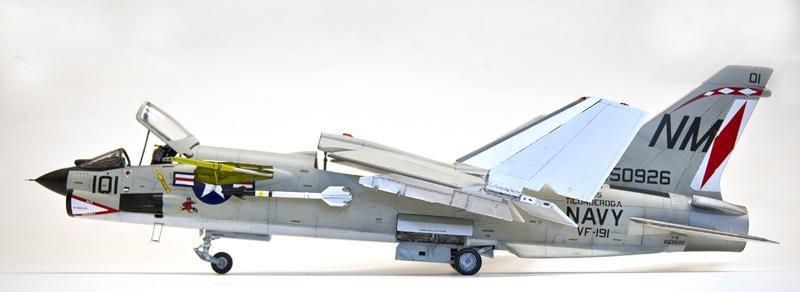
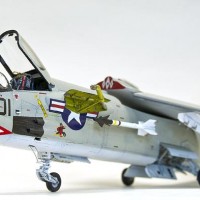
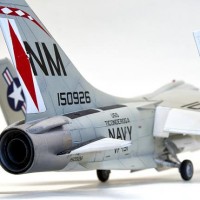
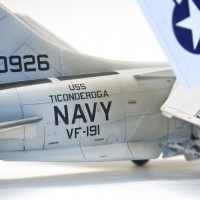

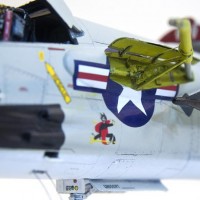

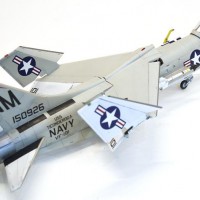
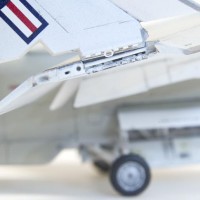
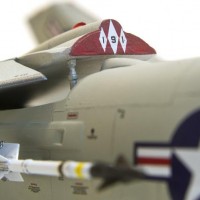
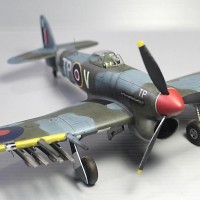

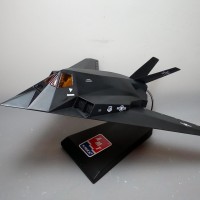
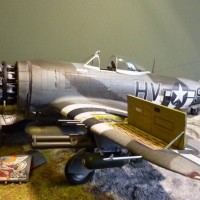
Amazing build! A great looking 'Tico gunfighter',
Thanks, Robert! The Crusader is probably my favorite jet. This makes number five!
Outstanding work, Drew...and an equally comprehensive accompanying article as well.
Thanks, Craig! sometimes I get a little long-winded in my articles. Thanks for wading through it!
Not at all...enjoyed your narrative and description of the build.
As you say, Drew, a lot of work has gone into this to bring it up to snuff, but it seems to have been worthwhile, and, you enjoyed it, which is having a hobby is all about. Great looking model, interesting reading and nice photographs, what's not to like?
Thanks, George! Really appreciate the comments.
Outstanding, Drew. The painting, build, & detailing are excellent as is your narrative.
Well done!
Thanks for your comments, Jeffry!
Awesome F 8! This is my favorite US Navy Vietnam era fighter. You did a great job on this Monogram classic!
Thanks, Morne! The Crusader is my favorite jet. This makes my sixth F-8!
Very, very nice Drew. The extra work was well spent and it shows in the finished model. Well done
Thanks, Tom!
Hey Drew- now its my turn to compliment you on your F-8! excellent- seeing this is making me want to finally push through on the Monogram E I have sitting in a box (along with other untouched ones) in the stash. I thought it was neat that I have detailed the exhaust on mine the same way that you have with a spare F-18 kit exhaust part! I snagged a lot of the Cobra parts way back for the ambitious F-8 build list.
Very nice build- looks awesome!
Dan - great minds think alike! Really appreciate the comments.
Hello Drew...My compliments on a nicely done Crusader. That's one of my favorite jets too. I especially enjoyed your detailed comments on the building of that kit and the tweaks you made to improve the basic kit.Your completed model turned out extremely well. All nicely done with good photography as well.
Thank you, Jim! Comments from a noted aviation author and historian like you are very much appreciated.
Looks fantastic! I love seeing these older, simple kits tricked out and painted and weathered to look realistic. Enjoyed the build narrative as well - as a modeler I'm more interested in a lengthy build report than details on the aircraft itself, as I can usually grab that info from other sources!
Thanks very much, Greg. I prefer reading build reports rather than aircraft histories, too!
WOW ! The mighty cruze! looks like a beast ready to jump and armed to the teeth ! great model congratulations !
Thanks, Kloster! I always thought the F-8 looked like it was going 1,000 miles an hour even the it was parked.
Hello Drew,
Monogram, always good.
Thanks for your detailed explanation of the build. You turned it into a winner. A real pleasure to see these old Monograms (1983?) boxes build.
Regards, Dirk / The Netherlands.
Thank you, Dirk! The Monogram F-8 was released in 1988. It was released again, by Revell, in 2012, with a different set of improved decals.
Well it ain't a Hasegawa kit but, it is affordable,build-able,correctable and like a good marriage love-able with a few flaws. The end results it looks like a duck,quacks like a duck and therefore is...
I used to work with a plumber, who was in the Navy and worked on F-8s. He talked about the engines being put on the engine stand and they'd test them. Run em up and put them in after burner. For %^&# and giggles they would pick up 15-20Ib rocks and thrown them into the rear end ...and watch the rocks shoot out onto the tarmac.
Two thumbs up Drew.
Thanks, Stephen! I appreciate you comments. And that's quite a story you friend told about the J-57 engine! Really wish I had been able to see and hear a Crusader in flight...
Beautiful Job Drew, fantastic details, congrats...
Thanks, Anthony!
Great job on the corrections. Did a quick eBay search for the cockpit set but running about 40$ in my part of the world so I'll leave everything as is when I get around to building mine